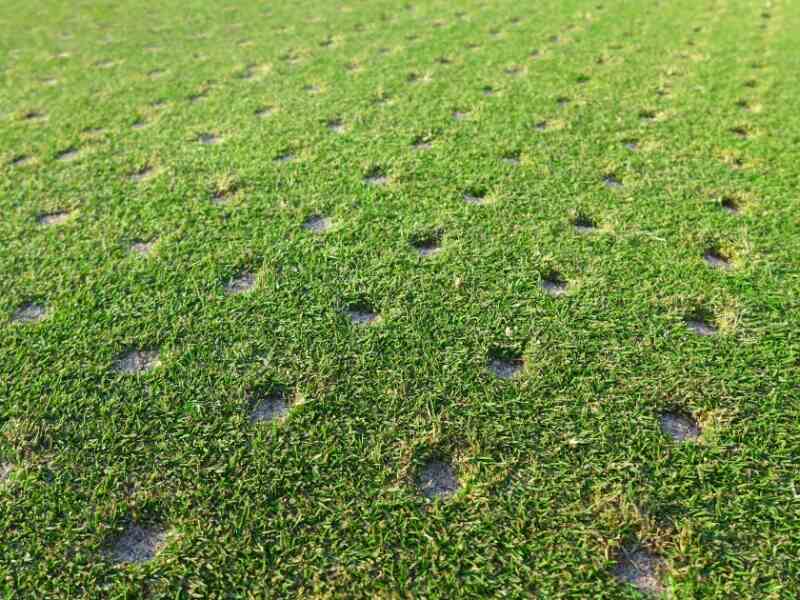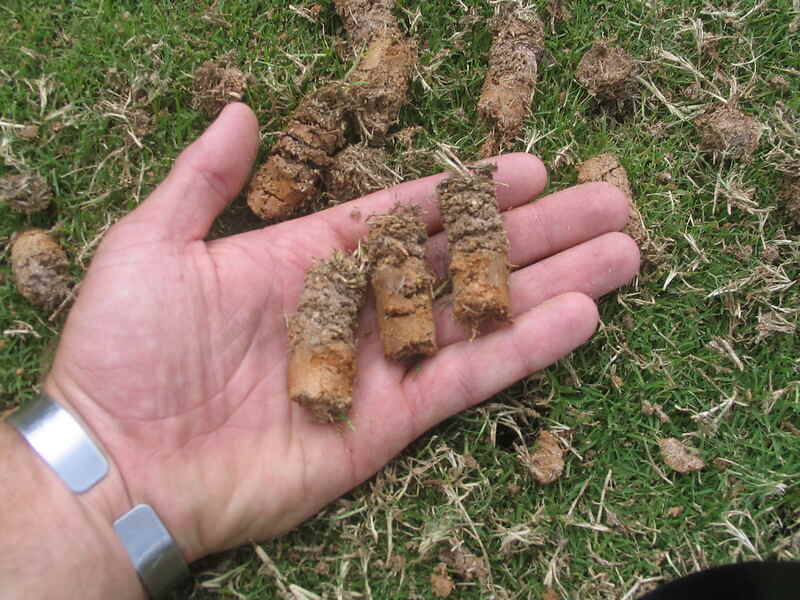The Benefits of Aerating Your Lawn
BY TAHA JAVED | AUGUST 7TH, 2023 | BLOGAeration is an essential but frequently overlooked part of lawn care. It means creating holes in the soil to loosen it up and make it easier for water and nutrients to reach your grass’s roots. We’ll go over the benefits of aerating your lawn to help you understand why this little-known lawn care practice is so important and worth doing regularly.
What are the Benefits of Lawn Aeration?

Photo Credit: driftlessstudio / Canva Pro / License
Lawn aeration provides various advantages that improve your lawn’s general health and appearance. Here are the biggest benefits of aerating your lawn.
Oxygen Boost
Plants, like humans, require oxygen to thrive. When your soil becomes compacted, the lawn’s roots struggle to get enough oxygen, resulting in weak and shallow root systems. Aerating your lawn allows oxygen to enter the root zone, encouraging the roots to grow deeper and stronger. Improved oxygen circulation promotes healthier grass growth, enhances drought tolerance, and lowers the risk of lawn disease.
Nourishing the Roots
Aeration stimulates not just oxygen circulation but also nutritional absorption by your grass’s roots. Compacted soil prevents nutrients – like the ones in lawn fertilizer – from reaching the root zone, resulting in undernourished grass. Aerating allows nutrients to infiltrate the soil, ensuring your grass obtains the nutrients it requires to thrive. Enhanced nutrient absorption leads to greener, denser, and more resilient turf.
Improving Moisture Penetration and Retention
In addition to oxygen and nutrients, water is essential for sustaining healthy grass. Compacted soil frequently results in water runoff and uneven moisture distribution. Aeration allows water to penetrate deeper into the soil, reaching thirsty roots.
Furthermore, the holes generated by aeration serve as reservoirs, allowing the soil to retain moisture for extended periods. This water-conscious method ensures appropriate hydration while reducing water waste.
Reducing Soil Compaction
Soil compaction is a typical problem, especially in high-traffic lawns. Compacted soil is dense and lacks air, water, and space for root development. Aerating breaks up the compacted soil, relaxing it and allowing the roots to expand. It will enable healthier grass growth, better drainage, and a better environment for beneficial soil insects like earthworms.
Eliminating Thatch
Thatch is a layer of dead grass, roots, and other organic matter that builds up between grass blades and the soil surface. While a modest covering of thatch can be good for your lawn, too much of it will cause difficulties, such as blocking water and fertilizer from reaching the soil.
Compacted soil promotes excessive thatch buildup by preventing decomposition. Aeration aids in the resolution of this problem by breaking up the thatch layer, promoting its decomposition, and preventing excessive build-up, which results in improved nutrient absorption in the soil
Promoting Strong Growth
A properly aerated lawn creates an environment where grass roots may grow deeper, resulting in a greener, lusher lawn. Stronger root systems provide the grass blades with better support, making them more resistant to wear and tear. Aerating your grass encourages general development, resulting in denser turf that tolerates stressors like heat, drought, and foot traffic.
Prevention Over Cure
Aeration is a proactive approach to lawn care rather than a reactive technique. You may avoid many problems like disease susceptibility, weed invasion, and uneven, lifeless grass by aerating your grass regularly. Aeration is a preventative strategy that keeps your lawn healthy and reduces the need for costly repairs or treatments later.
What is Lawn Aeration?

Photo Credit: Oregon State University / Flickr / CC BY-SA 2.0
To better understand the benefits of aeration, you should have a grasp on how the process works and why it’s necessary. Lawn aeration is the process of making small holes in the soil to improve air circulation, water penetration, and nutrient absorption.
Soil becomes compacted over time as a result of:
- High foot traffic
- Weather conditions like rainstorms
- Using heavy machinery
- Construction
- Heavy clay soil
This compaction hinders the passage of air, water, and nutrients deep into the soil, harming your grass’s health and growth. Aeration is the remedy that breathes new life into your lawn. Aeration can be done using:
- Core aerator: Also known as a plug aerator, it is a specialized mechanical method to penetrate the soil and extract small plugs to create holes and relieve pressure.
- Spike aerator: Unlike a core aerator, it works by puncturing the soil with solid spikes or tines to simply poke holes without extracting plugs.
Some homeowners may prefer liquid aeration products, which work on a smaller scale to break up compacted soil. Depending on the size and condition of your lawn, you can rent equipment or hire expert lawn care service providers.
To learn more about how aeration works (and how you can do it yourself), see our article on When and How to Aerate Your Lawn.
And if you decide to aerate on your own instead of hiring a pro, you’ll want to check out What to Do After Aerating Your Lawn to get the best results from your hard work.
FAQ About Benefits of Aerating Your Lawn
How frequently should I aerate my lawn?
The frequency of lawn aeration is determined by factors such as soil type, lawn usage, and soil compaction. Generally, you should aerate your lawn once a year if it has clay soil. But if you have soil that does not appear to compact easily, then it is advised to aerate once every three years.
What are some of the lawn care tips for aeration?
Consider the following tips to get the most out of your aeration efforts:
- To soften the soil, water your grass well a day or two before aerating.
- To avoid harming sprinkler heads, power lines, and other potential obstructions during aeration, mark them.
- When the soil is moderately damp but not too saturated or dry, aerate it.
- To achieve consistent coverage and avoid overlapping, follow a pattern.
- After aeration, leave the soil plugs on the grass to decompose and contribute to the organic matter of the soil.
- After aeration, overseed your lawn to encourage new grass growth and fill up any thin or bare spots leftover from compacted soil.
How to take care of your lawn after aeration?
Maintain a regular watering, mowing, and fertilizing schedule to encourage healthy grass growth. Avoid excessive foot traffic immediately following aeration to allow the grass to recover. You’ll reap the benefits of aeration for months if you properly care for your grass afterward.
When should you aerate your lawn?
Fall is the most active growing season for cool-season grasses like Kentucky bluegrass and fescue, so it is the optimal time of year to aerate them. On the other hand, warm-season grasses, such as Bermudagrass and Zoysiagrass, are best aerated in late spring or early summer.
Final Thoughts
Lawn aeration is a game changer when it comes to having lush, gorgeous grass. You may transform your lawn into an oasis of green by recognizing the benefits aeration brings. Regular aeration, whether you do it yourself or hire a professional, will keep your lawn healthy, resilient, and the envy of the neighborhood.
Get a free quote from local lawn aeration pros to embrace the power of aeration and unlock the full potential of your lawn today!